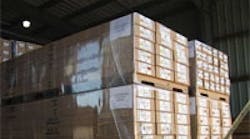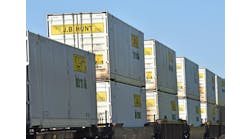Vytec (London, Ontario), ships vinyl siding in unusually long cartons. Typically these can range to 13 feet long. For years its crews built shipping crates around the product so customers could handle and stack pallets in their yards. Last year, Brian Hunter, logistics and warehouse operations manager, initiated a review of the costs associated with shipping siding products.
The end of the story is a new packaging process that is safer and more productive. Using disposable corrugated pallets, a spray palletizing adhesive and an orbital stretch wrapper, the company has cut its packaging labor by half and delighted customers with savings and efficiencies.
Vytec unitizes job-lot quantities of vinyl siding, 16 to 20 cartons per pallet, for the convenience of its dealers. Previously, the labor-intensive packaging process involved cutting runners, stringers and building pallets of varying lengths so that cartons could be stacked four wide by four high. Steel bands, plywood and nails were to hold the structures in place. Along with the added costs of shipping the structures, customers had to deal with dismantling the supports and cross members and disposing of huge pallets and mixed trash.
The packaging operation was also labor intensive. It required three shifts of six people to produce 81 pallets per day. The labor process, requiring pneumatic tools, resulted in an average of three accidents per year, some particularly serious. On the receiving end, customers also had cost and safety issues with dismantling crates, breaking up pallets and disposing of the associated wood and metal bands.
Hunter’s packaging simplification program with three major objectives -- reduce cost, improve handling and reduce customer disposal costs.
Turning to corrugated
The new program started with a disposable four-way pallet, manufactured by Corrugated Pallets Inc. (Kitchener, Ontario). Design and construction features include a solid corrugated deck and specialty reinforced runners, permitting an 8,000- pound load without flexing according to Christopher Casey, president, Corrugated Pallets. Rigidity is important because the 13-foot-long loads are loaded into trailers from the ends, and on to flat beds from the sides. Casey says efficiencies in pallet layout and a lower profile (compared with wood) often allows for an increase in trailer load density by up to 25%.
To wrap loads four or five cartons high, a Lantech (Louisville, Ky.) orbital stretch wrapper is used. During the initial planning, a number of wrapping options were tested for structural integrity. The columnstacked cartons, 10 feet to 13 feet long, had a tendency to slide and move off the pallets. This shingling effect cerated unloading difficulties that often required re-stacking. In addition, once the wrap was removed, columns on partial pallets had a tendency to spill.
Hunter was aware of a way to secure the load; Lock n’Pop (Lynnwood, Wash.) skid-resistant, lowtack adhesives. These adhesives keep packaging unitized, yet are essentially invisible. It does not damage packaging when cartons are separated.
How it’s done
The packaging process starts with a small amount of Lock n’Pop sprayed on the deck at each end of the pallet. The first layer of cartons is placed and a small amount of adhesive is sprayed on the top of the cartons. A two-foot wide sheet of regular Kraft paper is placed on the glued area, then is sprayed to adhere to the next layer of cartons.
According to Craig Howe, Palletizing Systems (the Canadian distributor for Lock n’Pop), integrating narrow ties with Lock n’Pop is a critical step for this application. Each of the remaining layers is built in this manner. The pallet load is then passed through the orbital wrapper where a nominal amount of wrap is used to secure the load. According to Hunter, the adhesive is an essential part of the packaging process because it creates a level of structural stability unachievable with stretch wrap alone.
Direct material costs of the new packaging process are roughly the same as they had been for wood and strapping. The good news is that Vytec’s labor productivity has increased by 100% to nine pallets per man hour.
• Staffing has been reduced to two shifts;
• Load capacities have increased;
• Lost time accidents associated with building, tearing down and disposing of crates have been eliminated.
Hunter describes the packaging project as a grand slam. “We not only achieved a significant logistics savings, we improved our safety, improved our customer’s safety, and reduced our customer’s disposal costs. Most importantly, we have gained an enormous degree of customer satisfaction."



